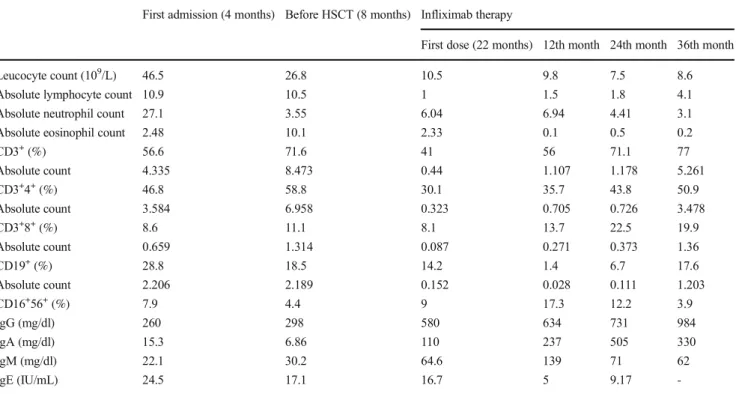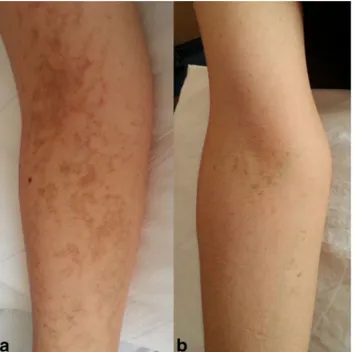Published online: 12 November 2019 BRIEF REPORT
Infliximab therapy for inflammatory colitis in an infant
with NEMO deficiency
Hasibe Artac1 &Ayca Emsen1&Hulya Ucaryilmaz1&Halil Haldun Emiroglu2&Vedat Uygun3&
Asbjørg Stray-Pedersen4
# Springer Science+Business Media, LLC, part of Springer Nature 2019
Introduction
X-linked ectodermal dysplasia with immunodeficiency (X-EDA-ID) is a rare disease caused by hypomorphic mutation in the gene encoding nuclear factor-κB (NF-κB) essential modulator (NEMO) [1–3]. Boys affected with X-EDA-ID have severely impaired host defense, are prone to life-threatening infections, and have susceptibility to atypical mycobacteria. They have also increase risk of inflammatory diseases, in particular inflammatory colitis. NEMO colitis usually occurs early in childhood, causes intractable diarrhea that is difficult to control, and is life-threatening.
A hematopoietic stem cell transplantation (HSCT) recon-stitutes the immune cells in NEMO deficiency, but it may worsen non-immune constitutional manifestations, in particu-lar the colitis because of the associated mucosal/epithelial de-fects that remain after HSCT [4,5]. TNFα blockage therapy was used as an effective treatment for the intractable NEMO colitis in a few cases [6–9]. We report here a 2-year-old boy with severe steroid refractory colitis caused by X-EDA-ID who was well responsive to infliximab, anti-TNFα monoclo-nal antibody. We observed that this treatment led to
improvement in both his severe inflammatory colitis and skin manifestations.
Case presentation
A 4-month-old boy presented with Staphylococcus aureus pneumonia, disseminated BCG vaccination, septicemia, and persistent diarrhea. At admission, physical examination re-vealed signs of anhidrotic ectodermal dysplasia with fine and sparse hair, absent eyebrows, thin translucent skin with dry eczema, and hyperkeratosis (Fig.1). He had also growth retar-d a t i o n , t h e f i n retar-d i n g s o f r e s p i r a t o r y retar-d i s t r e s s , a n retar-d hepatosplenomegaly. His initial laboratory examination showed hypogammaglobulinemia with normal T cell and B cell subsets (Table1). He had chronic diarrhea and chronic dehydration necessitating enteral feeding and ultimately total parenteral nu-trition dependence. The albumin replacement therapy about once a week was required for severe hypoalbuminemia because of enteropathy. No significant pathogen was detected by stool culture. All other infectious etiologies were excluded.
* Hasibe Artac hasibeartac@yahoo.com Ayca Emsen aycaceylan14@gmail.com Hulya Ucaryilmaz hulyaozdemir1@gmail.com Halil Haldun Emiroglu haldunemiroglu@gmail.com Vedat Uygun
veddat@hotmail.com Asbjørg Stray-Pedersen strayped@bcm.edu
1 Department of Pediatric Immunology and Allergy, Selcuk University Medical Faculty, Alaeddin Keykubat Kampusu,
42130 Konya, Turkey
2
Department of Gastroenterology and Hepatology, Selcuk University Medical Faculty, Konya, Turkey
3
Department of Pediatric Hematology and Oncology, Medical Park Antalya Hospital, Antalya, Turkey
4
Center for Human
Immunobiology-Immunology-Allergy-Rhematology, Texas Children Hospital-Baylor College of Medicine, Houston, TX, USA
https://doi.org/10.1007/s12026-019-09100-z
He was the third child of unrelated Turkish parents. Hyperpigmented lesions were detected in the extremities of his mother, sister, and grandmother (Fig.2). His genetic anal-ysis showed an X-linked disease-causing IKBKG mutation (c.1167dupC, p.Glu390Argfs*5 [NM_001099857]); his unaf-fected mother was a heterozygous carrier (69/284 reads by
using WES) [10]. Interestingly, the IKBKG mutant allele was observed in only 35% (55/159) of reads in the boy’s DNA extracted from blood. This finding was evaluated as revertant mosaicism, which could explain his relatively mild phenotype compared with classic IKBKG-associated immu-nodeficiency (MIM: 300291) in male subjects.
Fig. 1 Clinical appearance of the patient; (a) at admission, (b) before infliximab treatment, (c) and (d) are 18 and 36 months after infliximab treatment, respectively, (e) dental abnormalities
Table 1 Patient’s lymphocyte phenotyping and serum immunoglobulin levels at admission, before HSCT, and during infliximab therapy First admission (4 months) Before HSCT (8 months) Infliximab therapy
First dose (22 months) 12th month 24th month 36th month
Leucocyte count (109/L) 46.5 26.8 10.5 9.8 7.5 8.6
Absolute lymphocyte count 10.9 10.5 1 1.5 1.8 4.1
Absolute neutrophil count 27.1 3.55 6.04 6.94 4.41 3.1
Absolute eosinophil count 2.48 10.1 2.33 0.1 0.5 0.2
CD3+(%) 56.6 71.6 41 56 71.1 77 Absolute count 4.335 8.473 0.44 1.107 1.178 5.261 CD3+4+(%) 46.8 58.8 30.1 35.7 43.8 50.9 Absolute count 3.584 6.958 0.323 0.705 0.726 3.478 CD3+8+(%) 8.6 11.1 8.1 13.7 22.5 19.9 Absolute count 0.659 1.314 0.087 0.271 0.373 1.36 CD19+(%) 28.8 18.5 14.2 1.4 6.7 17.6 Absolute count 2.206 2.189 0.152 0.028 0.111 1.203 CD16+56+(%) 7.9 4.4 9 17.3 12.2 3.9 IgG (mg/dl) 260 298 580 634 731 984 IgA (mg/dl) 15.3 6.86 110 237 505 330 IgM (mg/dl) 22.1 30.2 64.6 139 71 62 IgE (IU/mL) 24.5 17.1 16.7 5 9.17 -Immunol Res (2019) 67:450–453 451
Hematopoietic stem cell transplantation (HSCT) was per-formed from HLA-match unrelated donor in the age of 9 months. He achieved maximal donor chimerism of 96% at month + 10, which then declined to 69% at month + 36. At approximately 4 years post-transplant, the chimerism decreased to 40%. Although he had HSCT, his rashes, poor weight gain, and severe intractable diarrhea were continued. In the begin-ning, endoscopy revealed mucosal redness and edema at his colon. High-dose corticosteroid therapy (methylprednisolone 2 mg/kg, daily) was started for NEMO colitis. Steroid therapy was partially effective in control of colitis and skin lesions, but it did not resolve completely clinical symptoms. In addition to corticosteroid, several alternative therapies (enteral budesonide, oral vancomycin, sirolimus, and tacrolimus) were used for co-litis. After the 10-month course of steroid and other treatment, follow-up endoscopy and colonoscopy showed chronic duodenitis, chronic gastric peptic ulcer, and chronic colitis.
The prolonged severe diarrhea that required G-tube feedings and total parenteral nutrition suggested TNF alfa blockage ther-apy. Informed consent concerning treatment was obtained from the patient’s parents. Before initiating infliximab, infections in-cluding tuberculosis and cytomegalovirus were rule out. Cardiac function was normal. In 22-month-old, infliximab was given intravenously over 2 h 5 mg/kg 0. 2. 6. week, with follow-up treatments every 8–9 weeks depending on clinical features. On the first day of infliximab treatment, temporary high blood pressure was observed. After infliximab infusion, the frequency of diarrhea dramatically decreased in a week and skin manifes-tations gradually resolved in years (Fig.1). Methylprednisolone treatment was reduced gradually and stopped in the sixth month of infliximab treatment. Neither mycobacterial infections nor
other infusion reactions were observed. Over the next year of treatment, improvement in stool frequency and a body weight gain of 3 kg were recorded. Colonoscopy after 18 months ad-ministration showed colonic aphthous ulcers with mucosal in-flammation (Fig.3). He had hospitalized two times for pneu-monia in 4 years. Infliximab was stopped at 40 months of treat-ment. Now, he is stable with prophylactic antibiotic and regular intravenous immunoglobulin treatment.
Discussion
The transcription factor NF-κB, a master regulator of pro-inflammatory responses, functions in gut epithelial cells to control epithelial integrity and the interaction between the mucosal immune system and gut microflora. NEMO deficien-cy led to increased sensitivity to TNFα-induced apoptosis of intestinal epithelial cells, impaired expression of antimicrobial peptides, and translocation of bacteria into the mucosa [11]. It was reported that TNFα was a key cytokine in the esis of inflammation and played a major role in the pathogen-esis in NEMO colitis. Steroids have always been the mainstay for NEMO-IBD and typically have been quite effective. However, TNF-related intestinal inflammation is responsible for the pathogenesis of NEMO-mediated NF-kappa B signal-ing defect [11]. Infliximab treatment suppresses the TNFα-mediated inflammatory response by inducing apoptosis of TNFα-producing cells. Herewith, we reported a case with NEMO defect which is treated successfully inflammatory bowel disease with TNFα antagonist in young age.
We observed two prominent problems related to HSCT in this patient: firstly, he had not achieved adequate engraftment; second, he had no improvement in the associated manifesta-tions of his disease. In particular, his skin lesions and colitis
Fig. 2 Hyperpigmented areas were located on the forearm of his mother and grandmother
Fig. 3 Colonic aphthous ulcers with mucosal inflammation: small hyperemic nodules with central erosions after 18-month infliximab treatment
Immunol Res (2019) 67:450–453 452
was not improved and even worsened. The inflammatory co-litis may be expected to potentially worsen with transplanta-tion in this patient. Although HSCT may correct the immune deficiency associated with NEMO, it does not affect the epi-thelial component [12,13]. By correcting immune deficit, immune cells can respond to intestinal bacteria and release increased inflammatory cytokines. The risk of life-threatening infections and post-HSCT complications should be evaluated in the HSCT decision.
In addition to the improvement of colitis symptoms, in our patient, infliximab led to resolution his skin findings including eczema and wounds. Nenci et al. showed that an inflammatory response requiring TNF receptor 1 signaling is essential for the pathogenesis of skin lesions in epidermis-specific NEMO-deficient mice [14]. This suggested that infliximab may also benefit in skin manifestations of NEMO deficiency. As a re-sult, anti-TNFα monoclonal antibody therapy should be con-sidered in intractable NEMO colitis and also non-immune findings cause by NEMO.
Acknowledgments We profoundly thank Dr. Jordan Scott Orange for a great support to diagnose NEMO deficiency in the case.
Compliance with ethical standards
Conflict of interest The authors declare that they have no conflict of interest.
References
1. Hanson EP, et al. Hypomorphic nuclear factor-kappaB essential modulator mutation database and reconstitution system identifies phenotypic and immunologic diversity. J Allergy Clin Immunol. 2008;122:1169–1177.e16.
2. Aradhya S, Courtois G, Rajkovic A, Lewis RA, Levy M, Israël A, et al. Atypical forms of incontinentia pigmenti in male individuals result from mutations of a cytosine tract in exon 10 of NEMO (IKK-gamma). Am J Hum Genet. 2001;68:765–71.
3. Pannicke U, Baumann B, Fuchs S, Henneke P, Rensing-Ehl A, Rizzi M, et al. Deficiency ofınnate and acquired ımmunity caused by an IKBKB mutation. N Engl J Med. 2013;369:2504–14.
4. Klemann C, Pannicke U, Morris-Rosendahl DJ, Vlantis K, Rizzi M, Uhlig H, et al. Transplantation from a symptomatic carrier sister restores host defenses but does not prevent colitis in NEMO defi-ciency. Clin Immunol. 2016;164:52–6.
5. Tegtmeyer D, Seidl M, Gerner P, Baumann U, Klemann C. I n f l a m m a t o r y b o w e l d i s e a s e c a u s e d b y p r i m a r y immunodeficiencies-clinical presentations, review of literature, and proposal of a rational diagnostic algorithm. Pediatr Allergy Immunol. 2017;28:412–29.
6. Toussi SS, Pan N, Walters HM, Walsh TJ. Infections in children and adolescents with juvenile idiopathic arthritis and inflammatory bowel disease treated with tumor necrosis factor-α inhibitors: sys-tematic review of the literature. Clin Infect Dis. 2013;57:1318–30. 7. Kelsen JR, Grossman AB, Pauly-Hubbard H, Gupta K, Baldassano RN, Mamula P. Infliximab therapy in pediatric patients 7 years of age and younger. J Pediatr Gastroenterol Nutr. 2014;59:758–62. 8. Mizukami T, Obara M, Nishikomori R, Kawai T, Tahara Y,
Sameshima N, et al. Nunoi H. Successful treatment with infliximab for inflammatory colitis in a patient with X-linked anhidrotic ecto-dermal dysplasia with immunodeficiency. J Clin Immunol. 2012;32:39–49.
9. Yang J, Cheuk DK, Ha SY, Chiang AK, Lee TL, Ho MH, et al. Infliximab for steroid refractory or dependent gastrointestinal acute graft-versus-host disease in children after allogeneic hematopoietic stem cell transplantation. Pediatr Transplant. 2012;16:771–8. 10. Stray-Pedersen A, Sorte HS, Samarakoon P, Gambin T, Chinn IK,
Coban Akdemir ZH, et al. Primary immunodeficiency diseases: genomic approaches delineate heterogeneous Mendelian disorders. J Allergy Clin Immunol. 2017;139:232–45.
11. Nenci A, Becker C, Wullaert A, Gareus R, van Loo G, Danese S, et al. Epithelial NEMO links innate immunity to chronic intestinal inflammation. Nature. 2007;446:557–61.
12. Fish JD, Duerst RE, Gelfand EW, Orange JS, Bunin N. Challenges in the use of allogeneic hematopoietic SCT for ectodermal dyspla-sia with immune deficiency. Bone Marrow Transplant. 2009;43: 217–21.
13. Miot C, Imai K, Imai C, Mancini AJ, Kucuk ZY, Kawai T, et al. Hematopoietic stem cell transplantation in 29 patients hemizygous for hypomorphic IKBKG/NEMO mutations. Blood. 2017;130: 1456–67.
14. Nenci A, Huth M, Funteh A, Schmidt-Supprian M, Bloch W, Metzger D, et al. Skin lesion development in a mouse model of incontinentia pigmenti is triggered by NEMO deficiency in epider-mal keratinocytes and requires TNF signaling. Hum Mol Genet. 2006;15:531–42.
Publisher’s note Springer Nature remains neutral with regard to jurisdic-tional claims in published maps and institujurisdic-tional affiliations.

